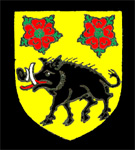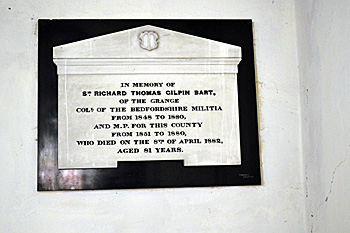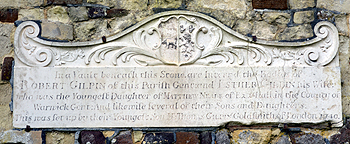The Gilpin Family

The Gilpin coat of arms
In Hockliffe and the Gilpin Family D. G. Soskin states that the first Gilpin of any note was one Richard Gilpin, who was reputed to have killed a wild boar which was terrorising the area around Kendal in Westmoreland [now Cumbria] in the fourteenth century. For this feat he was supposedly rewarded with a considerable estate based on Kentmere [Cumbria] and the right to bear arms of a Boar Sable with the motto Dictis factisque simplex ('sincere in word and deed'). A plaster copy of these arms can still be found on the side of Hockliffe Grange. A later Richard Gilpin was killed at the Battle of Bosworth in1485 fighting alongside King Richard III (1483-1485).
In the sixteenth century William Gilpin inherited both the Gilpin lands and his mother's property at Dalemain [Cumberland]. His career was eclipsed by those of two of his brothers. George Gilpin 'the elder' (so called to distinguish him from a nephew of the same name) had a successful career at the court of Queen Elizabeth (1559-1603), acting as her agent in negotiations with the Low Countries and as chief secretary to the founder of the Royal Exchange, Sir Thomas Gresham. He was also a noted translator, best known for his translation of Apiarum Romanum ('The Beehive of the Roman Church') by Philip von Marnix.
George's brother, Bernard, became known as the 'Apostle of the North'. After studying at Queen's College and Cardinal College (later Christ Church), Oxford, he became vicar of Norton. He was influenced towards Protestantism by Peter Martyr and Erasmus at Oxford and preached before Edward VI (1547-1553). Leaving Norton, he studied in Louvain, Antwerp and Paris, before returning to England and being appointed to the Rectory of Houghton-le-Spring [Durham] and the Archdeaconry of Durham, where he devoted much time and money to improving the state of his parish. After the restoration of the Roman Catholic faith in England by Queen Mary (1553-1559) his Protestant teaching resulted in a summons to London on a charge of heresy which would have led him to the stake at Smithfield. On his way to London his horse fell and Gilpin's leg was broken. By the time he recovered Queen Mary was dead, the religious order of the country had changed again, and Bernard Gilpin was able to return to Houghton-le-Spring, where he endowed a school and became renowned for his benevolence and hospitality. He was offered the bishopric of Carlisle but declined. In 1583 he died after being severely injured by an ox in Durham Market Place.
The descent of the Hockliffe Gilpins from the Gilpins of Kentmere is uncertain. Soskin believes the most likely connection is that Agnes Gilpin, a daughter of William Gilpin (brother of the eminent George and Bernard) married a kinsman Robert Gilpin, with whom she had three sons, Robert, Thomas and William. After the death of the elder Robert c.1595 his wife and sons moved south, probably to Buckinghamshire where they had relatives. The younger Robert Gilpin gained a degree at Oxford and in 1616 was appointed Rector of Hockliffe, where the advowson of Hockliffe, the Rectory and surrounding property including the Grange and the Lodge – probably at the time all part of a single estate - were apparently purchased for him. In 1624 Robert Gilpin married Margery Johnson at Ridgmont. The parish register shows that Margery outlived her husband by 56 years and died in 1697 "in the 97th [year] of her age". On Robert's death in 1641 his son-in-law Hezekiah Slingsby (husband of his daughter Catherine) was presented as rector to the church of Hockliffe by Robert's brother Thomas. In his will Robert Gilpin stipulated that he was to be buried in the chancel of Hockliffe Church, and left land at Great Brickhill [Buckinghamshire] and the advowson of Wavendon [Buckinghamshire] to his elder son Richard, and his Hockliffe estate for life to his wife Margery and then to his younger son Robert along with a £40 per annum income to be paid by Richard. The proceeds of the sale of the advowson of Hockliffe were to go to his daughters Catherine and Agnes, to be made up to a total of £600 if necessary.
Although the Hockliffe property had been left to his younger brother, the Heath Tax returns of 1671 show that Richard Gilpin had one house in Hockliffe with nine hearths, (this must have been Hockliffe Grange) and a second house with three, and that Catherine ('Widow') Slingsby had a house with four. Richard Gilpin's heir John, beginning something of a family tradition, became a goldsmith in the City of London. Neither John nor his brothers left any offspring, so after John's death in 1733 the family's property passed to the younger branch of the family, the heirs of the younger Robert Gilpin. This Robert had left his own estates to his widow Esther for life and then to his son Matthew. Like John Gilpin both Robert's youngest son Thomas and Matthew's son Robert were apprenticed to goldsmiths and later elected to the Goldsmith's Company. In this capacity Thomas Gilpin (1704-1763) made a large enough fortune to significantly increase the family's property in Hockliffe and the surrounding area. His acquisitions included the King's Arms Inn and Lower Farm in Hockliffe, two farms in Tebworth, Wingfield Farm, Mansion House and Farm in Wingfield, and land in Eggington. He also became a figure of local importance and was appointed High Sheriff of Bedfordshire in 1752 and his goldsmith's business went from strength to strength; when the Lord Mayor of London gave a banquet for King George III [1760-1820] and Queen Charlotte in 1761 the grand service of plate made for the Royal Table bore the mark of Thomas Gilpin, the initials TG under an acorn.

Memorial to Richard Gilpin July 2015
Thomas Gilpin's son Richard [1752-1841] attended Eton College and in 1767 was apprenticed to a goldsmith. In 1770 he left his master part way through the term and continued went to Cambridge to continue his education at Clare College. After he returned to Hockliffe he joined the Bedfordshire Militia, eventually rising to the rank of Lieutenant-Colonel in 1803 and becoming second in command until the militia was disbanded at the end of the Napoleonic Wars.

Memorial tablet to Richard Thomas Gilpin July 2015
Richard was succeeded by his son Richard Thomas Gilpin (1801-1882). After what appears to have been a mediocre career at Rugby School and Christ's College, Cambridge, Richard Thomas joined the army as a cornet in the 14th Light Dragoons but resigned from the regiment on the day he was promoted to captain, remaining in the army on half pay. Like his father he also joined the Bedfordshire Militia, eventually reaching the rank of Colonel, and became High Sheriff of Bedfordshire. He also served both as a Justice of the Peace and as Member of Parliament for Bedfordshire from 1851 to 1880, and in 1876 he received a knighthood. For his eightieth birthday he received a sixteenth century gold 'loving cup' valued at £150 from seventy-two friends and neighbours, including the Duke of Duchess of Bedford, the Earl of Roseberry and Leopold de Rothschild.
After Sir Richard Gilpin's death the Hockliffe Grange estate passed to his nephew Henry Meux Smith but the unfortunate heir died of heart failure only a month after his uncle. The estate was then divided between Smith's three daughters, with the eldest, Amy Mary Louisa, receiving the Grange. She married Peter Valentine Purcell of County Kildare, Ireland, who subsequently changed his name to Gilpin and was granted permission to use the Gilpin arms. Apart from a brief period in the 1880s the new Peter Valentine Gilpin did not live at Hockliffe and became an absentee landlord.

Gilpin vault inscription on the external east end of the church February 2013